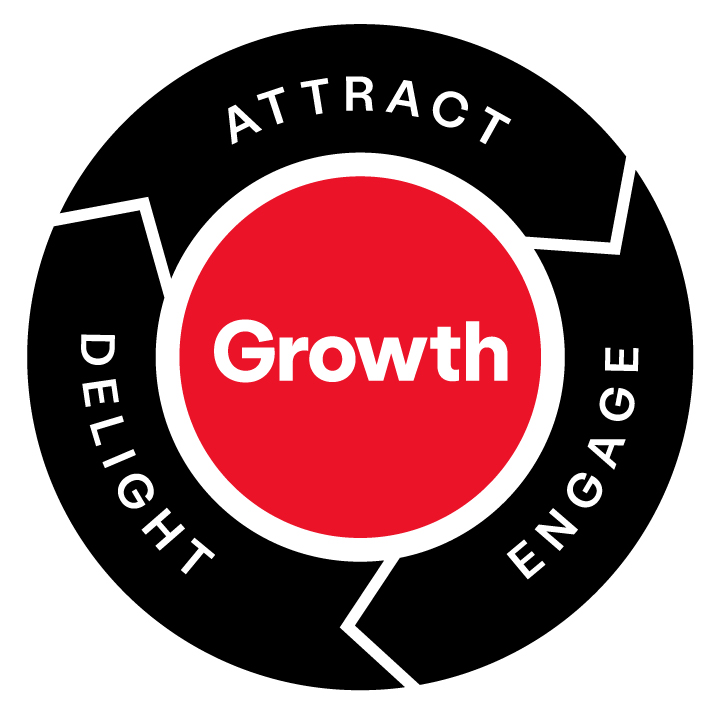Goodbye funnel, hello flywheel
The flywheel model differs from traditional sales funnels, as it focuses on how efficiently you can create growth. As people move through the stages of their customer journey, they move the flywheel and help your organization grow. How quickly can you spin the wheel? It depends on how frequently you reach your audience and if your messaging is resonating, among other things such as reviews and word-of-mouth reputation.

Micro-moments are signals that someone is in a specific stage of the customer journey and that there is an opportunity to move them forward. When looking for micro-moments, there are 6 customer journey stages to keep in mind, all of which exist at different parts of the flywheel:
1. Unaware: Attract
People in this stage aren’t aware of the problem they face, let alone how to go about solving it. For example, if you owned a digital marketing agency, your potential customers in this stage wouldn’t yet know that they could be getting more leads. Awareness marketing or word-of-mouth could help attract them, moving them to the next stage.
As you can see, marketing early in their journey pays off because it sets them down the path to investing in your solutions to a problem that they might otherwise have never even considered.
2. Problem-Aware: Engage
Now that they’re aware of the issue, you need to reach them with solutions. A person in this stage might search “how to get more leads,” and your content should come up.
3. Solution-Aware: Engage
Through your content marketing, you must help them tactfully solve their problem and then pivot to your solution. An example of a search term for this stage is “how to run Facebook lead ads.”
4. Product-Aware: Engage
They now know the problem they face and a way to solve it, but aren’t sure what the best way to attain that solution is. Your tactics in this stage need to pivot audiences not just towards the solution you’ve made them aware of – but towards your organization as a no-brainer next step. In this stage people might be searching “best Facebook lead generation agencies in Canada.”
5. Customer: Delight
After learning about how you can help them and becoming a customer, you can prove your worth – through things like product fulfilment, quality, and customer service.
6. Advocate: Delight
If you’ve done a good job at helping the customer, they’ll become an advocate for your brand. Advantages to this could include positive word-of-mouth about your organization, a case study/testimonial for your website, and more purchases from them in the future.
Of course, the actual specifics will vary, but every organization can benefit from thinking about how to integrate their own version of this strategy.
Let’s talk metrics
To measure the effectiveness of micro-moment marketing, consider your customer journey.
If you’re striving for impulsive purchases, attribution will be easier. You can see the click-through rates and even track the behaviour of users, right down to if they’re adding items to their cart and making a purchase.
If you’re in B2B or have longer sales cycles, it’s not as simple. Audiences might click your ad and sign up for a newsletter or download a resource – but they also might not. If your ad isn’t getting clicks, that doesn’t mean it’s not working. Users might see your content and search for your organization independently.
In this case, watch the correlation between your marketing efforts and site traffic. If organic searches suddenly tripled, it's likely attributable to your marketing. If your website has a newsletter sign-up, consider including a method for them to share how they found out about you. Then you can gain more insight into which platforms are working best.
There are other ways to measure micro-moments as well. You could think about what micro-moment signals are at each stage of your customer journey, and measure the results of each of those efforts. Measurements will change depending on the stage.
For instance, if you’re using email marketing in the Product-Aware stage, then you’d measure open and click-through rates. Or if you’re running a video on social ads, you can track the view-through of it. The advantage to this is that you can track how effectively people move through the stages, and see if they’re getting stuck at some of them. Then it’s just a matter of tweaking those individual tactics to reduce friction and keep people moving forward.
Keep in mind that when audiences see your social media marketing, they’ll likely be on a mobile device, where they may or may not be able to make a purchase. For some organizations, like universities, the purchases are made afterwards by applying on the computer. Make sure what you're measuring aligns with realistic audience behaviour. If Meta ads didn’t lead directly to click-throughs and then applications, that could be okay. If your site traffic hasn’t changed at all over the course of any campaigns, it’s time to review the strategy.